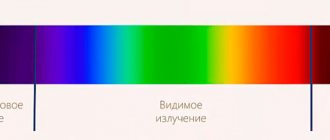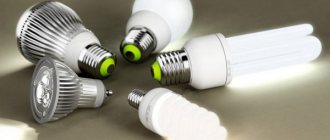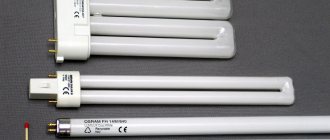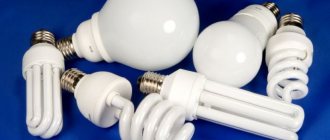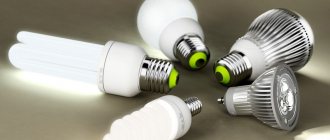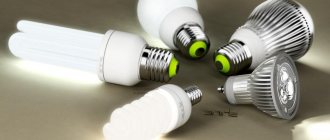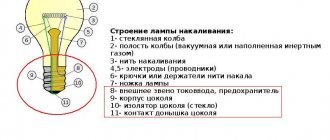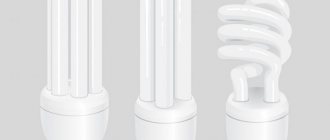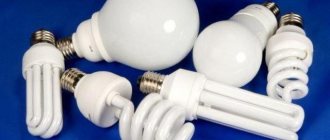Today the market offers a large selection of light sources: LED, well-known and familiar incandescent lamps, halogen and compact fluorescent lamps. The last of these versions are also called energy-saving, since they have successfully replaced their analogues with incandescent filament due to their low level of energy consumption.
In addition, there are models of such lamps with Edison socket (E27). For comparison, a special table of correspondence between the main technical characteristics of different types of light sources (luminous flux, power) has been created: energy-saving fluorescent, LED, incandescent.
What it is
Energy-saving lighting devices are electric lighting devices that have a large luminous flux while consuming minimal power. Compared to classic incandescent lamps, such devices provide low electrical energy consumption, but last significantly longer and are not inferior in lighting quality.
Example of an energy-saving device
In a broad sense, energy-saving devices are considered to be fluorescent lamps of various types and sizes, although with the development of technology a new type of lamp has appeared - LED.
Gas discharge devices
Comparison of illumination according to GOST
The samples are installed in a new headlight from Volkswagen Polo with a socket, then we measure the illumination of the control points. The voltage is 13.2 Volts on the lamp, not the power supply. This compensates for the reduction in voltage in the power wires.
| Name | 50L | 50R | 75R | Axial | Further |
| 1. PIAA Hyper Arros +120% | 8,2 | 26,1 | 26 | 25,6 | 33 |
| 2. Koito Whitebeam III Premium | 5,6 | 26,9 | 25,7 | 26,7 | 40,8 |
| 3. Fukurou F1 | 11,2 | 41,6 | 42,1 | 44,6 | 53,4 |
| 4. Philips Racing Vision +150 | 12 | 40,1 | 39,8 | 43,3 | 40,1 |
| 5. Osram Night Breaker Laser +150 | 11,8 | 38,2 | 40,8 | 38,4 | 31,5 |
| 6. General Electric Megalight Ultra +150 | 11,8 | 32,3 | 36,1 | 32,6 | 33,4 |
| 7. Bosch Gigalight plus 120 | 11,9 | 29,5 | 32,5 | 30 | 32,5 |
| 8. Champion +90 | 6,3 | 7,7 | 10 | 8 | 27,3 |
| 9. Osram Original | 10,5 | 27,3 | 30,3 | 28 | 33,2 |
| 10. GSL Standard +30% | 7,8 | 38,6 | 35,1 | 40,6 | 31,1 |
The results are surprising, even Philips and Osram significantly overestimate the real characteristics or hide them behind advertising figures +120%, +150%.
Since the luminous flux is almost the same (except for Fukurou F1) with a standard halogen lamp, you can change the illumination on the road in one way. The near spiral is moved closer to the base, the illumination in the center increases, but the illumination in the near zone decreases.
Lamp characteristics
The main characteristics of all produced energy-saving devices are:
Colorful temperature
When using devices with filament, it is problematic to obtain different color temperatures. With the advent of energy-saving devices, it has become possible to use white light lamps with different shades of color. According to color temperature, luminaires are:
- 6500K - cool white light, which is well suited for street lighting;
- 4200K is a neutral white, midway between cool and warm light. Suitable for use in residential, industrial, medical and other areas.
- 2700K - warm white light, creates coziness in the home and is used to illuminate residential areas.
Color temperature
Additional information! The choice of color temperature is individual and depends on the preferences of the person and the purposes for which the lighting will be used.
Base type
The type of base is standardized and comes in two versions:
- threaded: the designation of this base begins with the letter E and ends with a number that indicates the diameter of the base (E14, E27).
- pin: the marking begins with the letter G, and the numbers indicate the distance between the contacts.
Base types
Additional information! To buy a lighting fixture with the correct base, it is better to take the broken one with you to the store or look at the lamp’s passport.
You may be interested in this Features of the e14 cartridge
Life time
Energy-saving appliances are reliable and durable devices. Their service life is quite long and usually ranges from several thousand to tens of thousands of operating hours.
Note! It is important to understand that the service life is significantly affected by the number of on/off cycles. The more there are, the less the energy-saving lamp will last.
Luminous flux and luminous efficiency
Luminous flux is a physical quantity that shows the amount of light energy emitted per unit time. In the International System of Units (SI), it is measured in lumens (lm or lm).
The luminous efficiency of lamps shows the ratio of the luminous flux to the power of the device (lm/W). Old and inefficient incandescent devices have low light output (10-20 lm/W), more advanced energy-saving devices have a high efficiency and, accordingly, light output (about 50-100 lm/W).
Luminous output of lamps
Important! Light output may change over time with prolonged use. This change is normal and is associated with wear of the LEDs or deterioration of the properties of the luminescent device.
Power
An important characteristic of all electrical appliances is power. Lighting lamps are also no exception.
When using incandescent lamps, the amount of electrical energy consumed increases significantly. To avoid this, consumers are gradually switching to energy-saving devices, because they are energy efficient and have minimal lamp power with a high luminous flux.
Comparison table for lamps showing the correspondence between incandescent and energy-saving power:
| Power, W | Luminous flux, lm | ||
| Incandescent | LED | Luminescent | |
| 25 | 3 | 6 | 255 |
| 40 | 5 | 11 | 430 |
| 60 | 9 | 15 | 720 |
| 75 | 11 | 19 | 955 |
| 100 | 14 | 18 | 1350 |
| 150 | 19 | 45 | 1850 |
| 200 | 27 | 70 | 2650 |
Incandescent lamp comparison table
Note! On the packaging of LED and energy-saving devices, manufacturers often indicate an equivalent (for example, an 11-watt energy-saving lamp is equal to a 40-watt incandescent lamp), which corresponds to the power of an incandescent lamp. This is done not only for marketing purposes, but also for the buyer to understand the luminous ability of the device.
Price
The cost of premium H4 low beam halogen lamps differs from standard Philips and Osram lamps by 4-6 times. Usually the price is in the range of 1300-1700 rubles. per set. A standard H4 halogen installed by the manufacturer costs 150-200 rubles. a piece.
| Name | Price |
| 1. PIAA Hyper Arros +120% H4 | 1300 rub/set |
| 2. Koito Whitebeam III Premium H4 | 1650 rub/set |
| 3. Fukurou F1 H4 | 1600 rub/set |
| 4. Philips Racing Vision +150 H4 | 1200 rub/set |
| 5. Osram Night Breaker Laser +150 H4 | 1800 rub/set |
| 6. General Electric Megalight Ultra +150 H4 | 1350 RUR/set |
| 7. Bosch Gigalight plus 120 H4 | 1100 rub/set |
| 8. Champion +90 H4 | 300 rub/set |
| 9. Osram Original H4 | 320 RUR/set |
| 10. GSL Standard +30% H4 | 200 rub/set |
Lamps without packaging, arrangement as in the table.
Advantages and disadvantages
Advantages:
- Saving electricity: such devices have a high efficiency and low power with high light output. Compared to a traditional incandescent lamp, the electricity savings are significant (4-5 times).
- Long service life: conventional incandescent devices have a tungsten filament, which is sensitive to voltage changes and wears out quickly, so such devices do not last long. Energy-saving ones have a fundamentally different design and are able to work without replacement for a very long time (5-10 times longer than conventional devices).
- Low heat dissipation: in energy-saving devices, all electrical energy is spent on maximum light emission and minimal thermal energy emission, therefore, in comparison with conventional incandescent devices, they heat up significantly less and can be used in plastic or paper lamps and other materials that do not tolerate heat well.
- Possibility of choosing color temperature: as mentioned above, energy-saving devices have different color temperatures due to LEDs of different colors or shades of phosphor covering the body of the device.
You may be interested in How to arrange lighting in the garage
Flaws:
- High price: energy-saving lamps are significantly more expensive than traditional incandescent lamps due to the complexity of their production. For example, if an incandescent one costs 15 rubles, then an energy-saving one with similar lighting characteristics will cost from 100 to 150 rubles.
- Danger of fluorescent devices: such devices contain mercury and argon vapors, which are dangerous to the human body and can lead to poisoning if the lamp is damaged.
- The need for special disposal: due to the high hazard class, fluorescent lamps are toxic waste and require special disposal at the end of their service life.
- Difficult to adjust brightness: To adjust the brightness, special dimmers are required that can operate energy-saving lamps.
Main conclusions
Most ordinary citizens have no idea about energy-saving light bulbs, much less their types, features and advantages. The problem is also created by the discrepancy between the sizes of the flasks and caps and the parameters of the LN. Energy-saving CFLs most often extend beyond the lampshades, creating a feeling of discomfort. If the lamp has an adapter built into it, it is too heavy, limiting its scope of use.
When it comes to LED products, most buyers are put off by the high price and negative experience associated with cheap Chinese products purchased online. Not everyone wants to study information about driver design features and manufacturers. In such situations, most often the incandescent light bulb is simply replaced with a similar one. An exception is the owners of large apartments and country houses, who attract specialists to develop a lighting system.
Previous
Lamps and lampsRules for parallel and series connection of lamps
Next
Lamps and luminairesCharacteristics and advantages of filament LED lamps
Design
In general, a compact luminescent device consists of a bulb, an electronic board and a base.
Fluorescent lighting device
Sealed glass tube
The flask is a hollow type (or a sealed curved glass tube), which is connected with its terminals to an electronic board.
Types of flasks
Inert gas inside it and mercury vapor
Such a tube is filled at the factory with special gases (mercury vapor, argon and other gases). Such gases are very dangerous for humans if the device is damaged, and it is important to be careful when using fluorescent energy-saving devices.
Phosphor layer
The body of the gas-discharge device is coated with a special composition - phosphor (a mixture of calcium halophosphate and other elements).
An electric discharge creates ultraviolet radiation in a flask with mercury vapor, which is changed into a visible light flux using a phosphor.
Electronic board
The electronic board in gas-discharge devices is an important component, and the service life and quality of its glow depend on the quality of its assembly. Structurally, such a board consists of:
- The thermistor is an element that ensures a smooth start of the device and helps to warm up the lamp coils without blinking.
- The starting capacitor is the element that directly starts the device.
- Filters - protect the electronic board from interference;
- Capacitive filter - reduces pulsations and eliminates flickering of the device;
- Current-limiting choke - stabilizes the device and limits the current;
- Fuse - protects the device and turns off the lamp when overloaded;
You may be interested in How to make lighting in the kitchen
Principle of operation
A voltage is applied to the dinistor, which forms a pulse. This pulse arrives at the transistor and causes it to open. As soon as the start is made, the circuit is closed by the diode bridge, the capacitor is charged and re-opening does not occur.
The transistor operates on a transformer with several windings and a ferrite core. Voltage is applied to the transformer filaments and a glow appears in the bulb. In this case, the voltage reaches a high value (up to 600 V).
When the inert gas in the flask is completely ionized, the voltage is reduced to sufficient to maintain the lamp glow, which ensures the energy-saving properties of the lighting device.
Selecting a lighting fixture
Power
To measure power consumption, set the voltage on the lamp to 13.2 Volts.
The maximum power at low beam differs by +10% from the standard one. At a distance it differs only by +2%. Tests show that the power is practically the same as the standard model. Some car enthusiasts are afraid that expensive models will heat up the headlight more, and the reflector or lens will become cloudy. There will be no consequences, the service life of the headlight will remain the same.
| Name | Near | Further |
| 1. PIAA Hyper Arros +120% H4 | 72w | 78w |
| 2. Koito Whitebeam III Premium H4 | 70w | 74w |
| 3. Fukurou F1 H4 | 71w | 77w |
| 4. Philips Racing Vision +150 H4 | 71w | 77w |
| 5. Osram Night Breaker Laser +150 H4 | 70w | 77w |
| 6. General Electric Megalight Ultra +150 H4 | 65w | 77w |
| 7. Bosch Gigalight plus 120 H4 | 65w | 68w |
| 8. Champion +90 H4 | 65w | 76w |
| 9. Osram Original H4 | 65w | 76w |
| 10. GSL Standard +30% H4 | 69w | 76w |
How to choose
When choosing a lamp, you should consider the following parameters:
- Required type of base;
- Colorful temperature;
- Light output;
- Lamp power;
Energy-saving devices are a modern and effective solution for any room and purpose.
Comparison of the size of traditional incandescent devices and energy-saving devices
To summarize, it is important to know that when choosing an energy-saving appliance, you need to focus on a reputable manufacturer. Such manufacturers monitor the quality of their products at their factories and the risk of stumbling upon a defective product is minimal.
Application area
When energy-saving lamps appeared, they were more often used in office premises. Over time, they began to actively fill markets and electrical goods stores. This led to the fact that the cost of “housekeepers” decreased and their availability increased for all categories of the population.
Energy-saving lamps are a great way to save electricity, which is becoming more expensive every year.
Having tested energy-saving light bulbs in action, people are convinced of their effectiveness and try to switch only to this type of lighting.
These lamps are mainly used in residential areas. Less commonly used in cellars, hallways and corridors, as well as for illuminating the territory of a private house at night.
The use of such lamps is also widespread in the housing and communal services sector. In staircases, where conventional lamps often burn out, “housekeepers” are very convenient to use. Their service life allows them to be used for a long time. Even if a defect occurs in the device and the lamp burns out before the specified period, it can always be replaced under warranty. Every year, more and more residential sectors are switching to energy-saving types of lighting.
ESL dimming
For ESL, combustion is maintained at a power of at least 10% of the nominal value, but to start the dimmer must be set to a level of at least 30%, and after turning on the lamp it can be reduced.
It is advisable to use brightness regulators on triacs, without rectifying the current, which makes it possible to save on the absence of power losses from diode bridges. Despite this, the dimmer is an additional burden. In addition, “cold starts” cause fluorescent lamps to fail faster. The dimming depth of conventional lamps is very low, and to expand it and ensure the necessary safety margin, you should buy special expensive lamps with special electronic filling.

